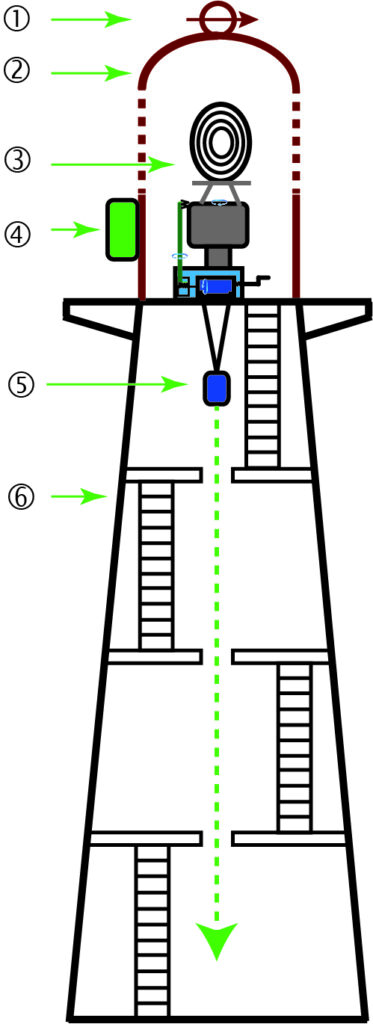THE ANATOMY OF
SHERINGHAM POINT LIGHTHOUSE
1. Weather Vane
The weather vane indicates the wind direction. Sheringham Point Lighthouse is also a designated weather station and has equipment that records the temperature, pressure, humidity, wind speed and direction, and broadcasts this information to the Department of Environment and Natural Resources for distribution to weather forecasters across the country.
2. Lantern Room
The red metal lantern room at the top of the tower houses the light. Cast iron walls and supporting posts hold up a copper roof. There are 36 curved windows, 1 metre (3ft) square, in 3 rows of 12. The lantern room is 8.5 metres (28 ft) high, and 3 metres (10 ft) in diameter. It has both an internal and external catwalk at the base of the windows.
3. The Lantern
The lantern is the heart of the Lighthouse operations. It has several components:
LENS – Originally a 3rd Order Fresnel Lens was installed. It was replaced in later years by an electronic lens – a Crouse-Hinds DCB36. At the centre of the lens was a lamp that produced the illumination. Originally it was an oil lamp, later replaced with electric lamp.
BASE – Made of cast metal, approximately 2.5 metres (8 ft) high. Its components include the top plate and stand (to which the lens is attached), a large pan containing a bed of mercury, and a lower pedestal that anchors the base to the floor of the lantern room.

CLOCKWORK (ROTATION) MECHANISM – This was a series of heavy-duty steel gears and shafts, with a central drum around which was wrapped a steel cable. It was originally cranked by hand, and in later years, by an attached electric motor.
4. The Beacon
Although no longer a functioning lighthouse, Sheringham Point remains a designated “Navigational Aid” with an automated green beacon attached on the exterior of the lantern room. It flashes every 15 seconds during the night.
5. Counterweight
The counterweight is a 180 kg (400 lbs) weight, attached to the clockwork mechanism by a steel cable. It moves down through the entire length of the tower, and as it does so, it rotates the lens.
6. The Tower
The reinforced concrete tower is 12.2 metres (40 ft) high and is about 4.6 metres (15ft) in diameter at the base, narrowing to about 3.5 metres (11 ft) near the top, then flaring out to provide a 4.9 metre (16 ft) platform at the top. The design is hexagonal, with six structural buttresses that provide significantly increased strength and stability. Access to the top of the lighthouse is by 4 sets of steep ladders stretching from the ground floor entrance via three interior platforms and entering the lantern room through a hatch.





